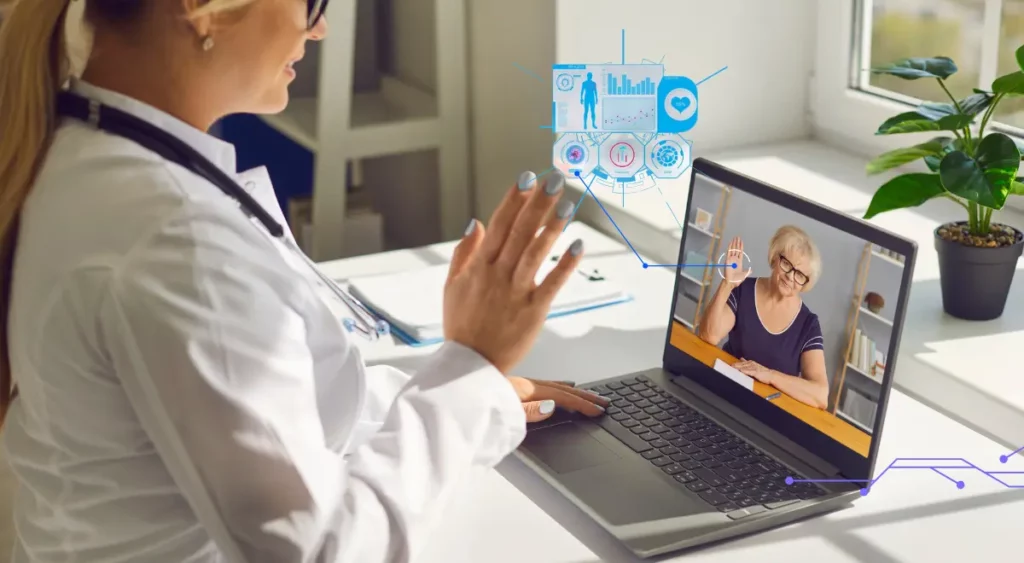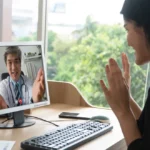Future Trends in RPM and CCM for Remote Healthcare in the United States

By 2025, the remote monitoring industry is projected to grow to $175.2 billion, driven by AI advancements, telemedicine expansion, and increased reimbursement policies. As digital healthcare platforms continue evolving, these emerging trends will reshape how healthcare is delivered remotely across the U.S.
Modern day healthcare is changing the way people receive care and treatment with its accessible, convenient, and efficient approach. Two vital components of this change are Remote Patient Monitoring (RPM) and Chronic Care Management (CCM), both being set to play important roles in the future of healthcare delivery models.
RPM and CCM are popular remote care programs adopted by healthcare providers to offer personalized, efficient, and affordable care to patients suffering from various chronic conditions. In this blog, we will pinpoint some future trends regarding remote healthcare delivery in the United States.
Table of Contents
ToggleWhat is RPM and CCM?
Before understanding the future trends in the remote care model, let’s first understand what RPM and CCM is and how it works.
- Remote Patient Monitoring (RPM): Remote patient monitoring is at the center of today’s rapidly evolving healthcare industry and allows providers to monitor the health of patients outside of clinical settings. RPM plays an active role in improving patient participation through self-monitoring.
Patients record their health data regularly via blood pressure monitors, weight scales, glucose monitors, and other such connected devices. Readings from these devices are automatically transmitted to the RPM system, where the clinical staff monitors them for any abnormalities/ fluctuations, analyzes the patient’s symptoms, and tailors a personalized treatment plan after scheduling a virtual consultation with the patient to improve health outcomes.
- Chronic Care Management (CCM): Chronic care management refers to healthcare delivery services to patients with chronic illnesses, like asthma, diabetes, heart ailments, hypertension, cancer, and others. Continuous care allows easy management of symptoms, prevents complications, and improves general health, thereby decreasing severe health risks.
CCM involves regular monitoring, personalized care plans, and frequent communication between patients and healthcare providers with an aim to reduce hospital readmissions and enhance quality of life for individuals with long-term health conditions.
Remote Patient Monitoring & Chronic Care Management Trends in 2025
Trend 1: Integration of Telemedicine with RPM and CCM
Remote patient monitoring and chronic care management will see significant integration of telemedicine with remote monitoring technology. Telemedicine has seen huge momentum recently, especially during COVID-19 when in-person visits were reduced due to travel restrictions. The ability to conduct virtual consultations with healthcare providers has improved access to care and reduced pressure on healthcare facilities.
In 2025, we can foresee an improved integration of telemedicine with RPM and CCM. This integration will allow the providers to modify the treatment plan in real time based on the health data collected from the patient, thus ensuring patient-centered care and increased patient satisfaction.
Also, telemedicine platforms can be expected to build upon the AI-based decision support tools for healthcare providers to evaluate complex datasets. This will empower health professionals to make well-informed decisions without the necessity of in-clinic visits.
Trend 2: Growth of Artificial Intelligence (AI) and Machine Learning (ML)
The second trend most likely to gain prominence and adoption is the growth of artificial intelligence and machine learning in the remote healthcare industry. Since AI and ML can completely change the way healthcare providers monitor or manage the health status of their patients, they’ll be an integral component of RPM and CCM software.
AI and ML algorithms can analyze large amounts of patient data that have been collected through RPM devices to find patterns in patient’s well-being and predict health risks and customize care plans. For example: An AI-enabled system can help predict when a patient’s health is likely to worsen by identifying the rise of blood pressure over a few days or an abrupt change in heart rate. This early detection allows healthcare providers to prevent future hospitalizations, which generally reduces the healthcare costs.
Not only this, AI and ML can help develop better chronic care management plans. They can analyze past health data of the patient and assist providers in identifying which form of treatment will help the most.
With AI-powered virtual assistants, patients can get reminders about the medication refills, virtual appointments, health alerts, and more.
Trend 3: Expansion of Wearable Health Technology
In 2025, AI-driven RPM platforms will feature predictive analytics, real-time risk scoring, and automated alerts to help providers intervene before a condition worsens. New-generation wearables will include sweat biomarker sensors, continuous glucose monitors with AI-driven alerts, and AI-enhanced ECG monitoring for heart disease detection.
Wearable devices are the future of remote patient monitoring and have already gained popularity for the convenience and ease of use they offer when monitoring and recording vitals. Innovations in the wearable technology will lead to the evolution of even more sophisticated yet comfortable wearables that can help track even more health metrics.
The data collected from wearables will be automatically transferred to healthcare providers who’ll then monitor patient health so that they can intervene whenever the need arises. Wearables may even involve built-in AI capabilities that provide real-time feedback to patients regarding possible health concerns or changes in their condition.
Trend 4: Improved Patient Engagement and Empowerment
RPM and CCM will continue to shape the future of remote healthcare by improving patient engagement and empowerment. Remote monitoring in future would allow patients with immediate access to their health data through the applications/portal into which patients could log on to track progress, set health goals, and communicate directly to their healthcare team.
Modern RPM platforms may provide personalized health tips and recommendations based on the data collected by remote monitoring devices. For example, if glucose levels are constantly high, maybe suggestions will be given to avoid certain foods or remind patients they need to check their blood sugar levels more regularly. Patients are empowered in their self-care this way and take well-informed actions to improve their health.
In 2025, remote healthcare technologies will focus on mental health across all platforms. In fact, most chronic conditions such as diabetes and heart disease are associated with conditions like anxiety and depression. This will also be one of the scopes for expansion of RPM and CCM this year.
Trend 5: Policy and Reimbursement Changes
The future adoption and incorporation of remote healthcare technologies into an existing healthcare system depends on the role played by the policymakers and insurance providers. Developments in reimbursement policies for telehealth and remote monitoring services have come a long way and continue to evolve over the last few years.
There is going to be further expansion in reimbursement for RPM and CCM in the future. While the Centers for Medicare and Medicaid Services (CMS) have been leading the way in reimbursement for telehealth services, private insurers are also beginning to follow suit. Policymakers would step in with this trend, implementing policies that would boost a widespread adoption of the remote healthcare technologies while ensuring they remain accessible to the population.
As data privacy and security regulations evolve, there will be additional efforts to protect patient information. The Health Insurance Portability and Accountability Act (HIPAA) would evolve to cover some more security and compliance issues like, storage and transfer of health data.
Trend 6: Interoperability and Data Integration
The future of RPM and CCM relies on FHIR and HL7 compliance that plays a significant role in improving health data exchange across different digital health platforms. AI-driven interoperability solutions will help automate data consolidation and provide healthcare providers with a unified view of patient health data across multiple systems.
With a rise in the use of RPM and CCM solutions, one of the key challenges to be addressed in 2025 is how they interoperate with one another, with other devices or platforms, and existing healthcare systems.
In the future, there will be more requests to have data derived from the various RPM and CCM platforms formatted in such a way that they flow into a provider’s EHR without hindrance. This way, the providers will have a full view of the patient’s medical history, including information collected by remote monitoring devices, within a single system.
Patients are also expected to feel more empowered when it comes to their health data because they will be in a position to share it with other providers, or specialized providers, or make it easily available for family members.
Enhance CCM & RPM Experience With HealthArc
In 2025, RPM and CCM are expected to make the healthcare delivery system even more accessible, cost-efficient, and, most importantly, patient-centered like never before when proper infrastructure and regulatory frameworks are in place.
HealthArc’s AI-powered RPM and CCM solutions are designed to help providers reduce hospitalizations, optimize reimbursement, and deliver real-time predictive analytics for better patient care. Our remote patient monitoring and chronic care management software is designed to scale your healthcare goals and make patient monitoring and care management easy.
Our suite of FDA-approved remote monitoring devices, patient communication and interaction capabilities, a dedicated customer success team, clinical software, physician dashboard, and billing capabilities provide a comprehensive solution.
Please request a free demo to see how our cutting-edge technology can enhance your practice goals. Also, feel free to talk to our team at +201 885 5571 for any queries about the CCM and RPM services.
Frequently Asked Questions (FAQs)
CCM uses RPM’s real-time device health data to make customized treatment plans for chronic illness. This collaboration ensures proactive, data-driven care, lowers hospitalization rates, and increases patients involvement in their treatment.
Some of the biggest developments are predictive care analytics powered by AI, easy integration of telemedicine, more reimbursements from CMS, the introduction of new wearable devices, and improved connectivity of EHRs. These developments are expected to transform the remote delivery of healthcare by 2028.
Large health records from RPM devices are automatically processed and analyzed by artificial intelligence (AI) to predict health risks, including cardiac problems etc. This facilitates the work of providers, enables them to intervene early, and enhances patient outcomes by providing them with precise, data-driven insights.
Providers can improve patient care delivery and can make more money through CMS payments (for example, CPT 99454: $43.02/month), and use AI to automate tasks by using real-time data. High patient satisfaction ratings (90%) also lead to patient retention and attract new patients.
Providers can use real time data to improve patient medical treatment delivery and can make more money through CMS payments (for example, CPT 99454: $43.02/month).High patient satisfaction ratings (90%) also patient retention rate and attract new patients.
Smart scales, wearable biosensors for heart rate, continuous glucose monitors, and Bluetooth blood pressure cuffs are examples of RPM devices. All have FDA approval and easily share data with platforms such as HealthArc.
CMS supports CCM with new APCM codes for complex cases and RPM with codes such as CPT 99457 ($47.87 for monitoring). Providers must adher to strict billing procedures to maximize reimbursements and maintain compliance.
CMS and FDA will prioritize EHR interoperability, approve new RPM devices, streamline billing with updated CPT codes, and increase reimbursements. The goal of these modifications is to increase adoption while preserving data security and HIPAA compliance.
For underserved and rural patients, RPM removes travel obstacles, allowing for virtual care and ongoing monitoring. By 2030, 80–90% of outpatient visits might be conducted virtually, guaranteeing that everyone has fair access to high-quality medical care.
Problems include high setup costs, low digital literacy, increased provider workload, and data privacy concerns (22% of patients). These are addressed by platforms such as HealthArc, which use automation, user-friendly interfaces, and HIPAA-compliant systems.
FDA-approved equipment, AI-driven analytics, smooth EHR integration, and automated RPM and CCM billing are all offered by HealthArc. HealthArc’s patient-focused dashboards and apps improve engagement; schedule a demo by calling (201) 885-5571.
RPM and CCM save $1,000 per patient yearly, provide 90% patient satisfaction, and cut readmissions by 76%. Adopting these programs is a strategic move for providers, as the RPM market is expected to reach $42 billion by 2028.
Most Recent Blogs
Categories
Related Blog
- November 26, 2025 | Read Time: 14 mins
Return on Investment (ROI) of Remote Patient Monitoring (RPM): A Complete Guide for ACOs and Healthcare Organizations
The U.S. healthcare system continues its transition from fee-for-service models to value-based...
Learn More- November 24, 2025 | Read Time: 15 mins
Common RPM Pricing Models for Providers: A Profitability-Focused Guide
Remote Patient Monitoring (RPM) has rapidly emerged as one of the leading...
Learn More- October 23, 2025 | Read Time: 12 mins
How RPM Devices Improve Hypertension and Diabetes Outcomes in Medicare Populations
Remote patient monitoring (RPM) is transforming chronic care for Medicare beneficiaries. CMS...
Learn More


